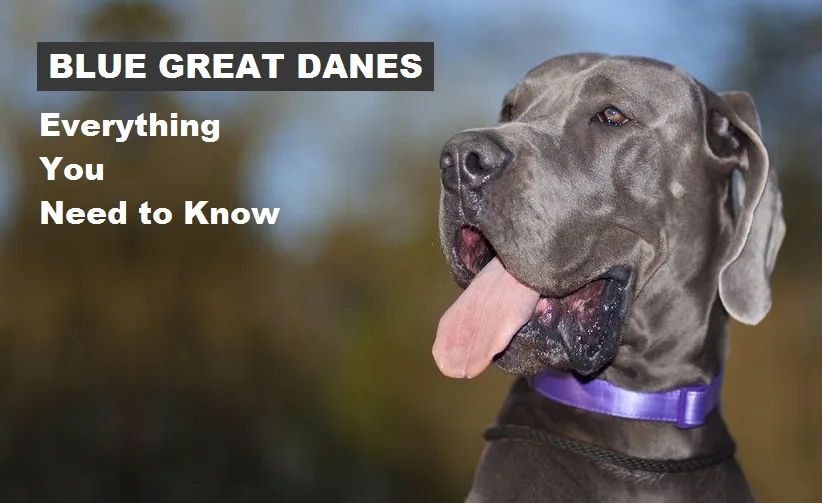Table of Contents
If you’ve ever dreamed of having a canine companion that’s equal parts majestic and gentle, let me introduce you to the world of the Blue Great Dane. These gentle giants are like a living work of art, with their striking blue coats and towering presence.
In this guide, we’ll take you on a journey through the fascinating world of Blue Great Danes, from their history and unique characteristics to their care and training. So, fasten your seatbelts (or leashes), because we’re diving into the world of these magnificent dogs!
What defines the Blue Great Dane breed?
The Blue Great Dane is a special variation of the already majestic Great Dane breed. These giants are renowned for their regal stature, often towering above most other dog breeds. However, their allure goes beyond their size. With a coat that shimmers like a sapphire gem and a personality that’s as gentle as a whispering breeze, Blue Great Danes are the embodiment of elegance and charm.
How did the Blue coat pattern emerge?
The emergence of the Blue coat pattern in Great Danes is a fascinating story. It’s a relatively recent addition to their genetic makeup, dating back to the 17th century. These beautiful blue coats are a result of careful breeding and genetic selection, making Blue Great Danes a unique and captivating variation within the Great Dane family.
Characteristics of Blue Great Danes
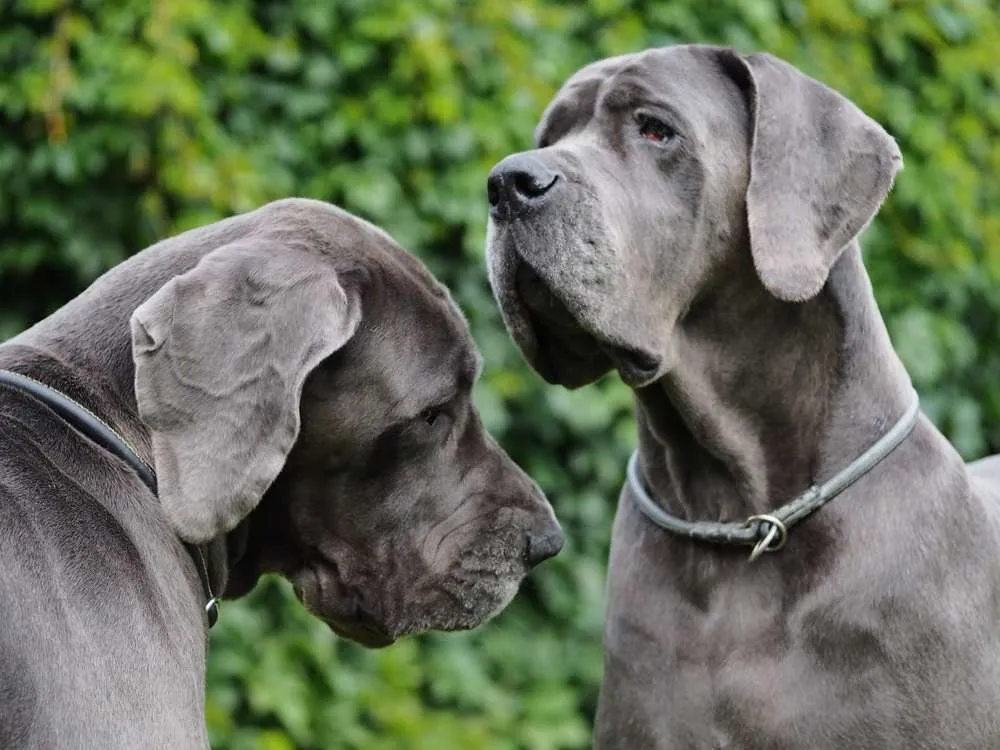
Physical Appearance: A Towering Presence
When it comes to physical appearance, Blue Great Danes are truly the giants of the canine world. Adult males typically stand at an impressive height of around 30 to 32 inches at the shoulder, while females reach a still-stately 28 to 30 inches. These dogs are not just tall; they’re powerfully built, with well-muscled bodies that exude strength and grace.
Coat Color and Texture: Shades of Blue
What sets Blue Great Danes apart is their stunning blue coat. This unique coloration is like a piece of the sky on four legs. The coat is short, sleek, and smooth to the touch, giving them an elegant and regal appearance. Shades of blue can vary, ranging from a deep steel blue to a lighter, more silvery blue, but they all share that distinctive and enchanting hue.
Size and Stature: Bigger Than Life
Beyond their coat, their size and stature are nothing short of awe-inspiring. Male Blue Great Danes typically weigh between 140 to 175 pounds, while females weigh in at a still-hefty 110 to 140 pounds. These majestic creatures are a true testament to nature’s grandeur.
Temperament and Personality Traits: Gentle Giants
Now, let’s talk about what truly makes Blue Great Danes special: their temperament and personality. Blue Great Danes are known for their unwavering loyalty and gentle nature. They have hearts as big as their bodies and are incredibly devoted to their families. With a Blue Great Dane by your side, you’ll have a furry friend who is always there, ready to offer comfort and companionship.
Intelligence and Trainability: Bright and Willing to Please
Don’t let their size fool you; Blue Great Danes are intelligent dogs. They have a knack for learning quickly and are eager to please their owners. However, they can also be a bit stubborn at times, so training should be done with patience and positive reinforcement. With the right approach, these gentle giants can excel in obedience and make for well-mannered companions.
Common Health Considerations: Navigating Size-Related Issues
While Blue Great Danes are undeniably magnificent, their size does come with certain health considerations. Due to their large frames, they are more prone to specific health issues, such as hip dysplasia and bloat. Regular veterinary check-ups and a balanced diet are essential to keep these gentle giants in optimal health. Proper care and attention can help them live long, happy lives while minimizing the potential pitfalls of their size.
In a nutshell, Blue Great Danes are not just breathtaking in appearance but also possess hearts of gold. Their loyalty, intelligence, and gentle nature make them extraordinary companions. However, their unique size also require diligent care to ensure they thrive and enjoy a life as majestic as they are.
Blue Great Dane Care and Maintenance
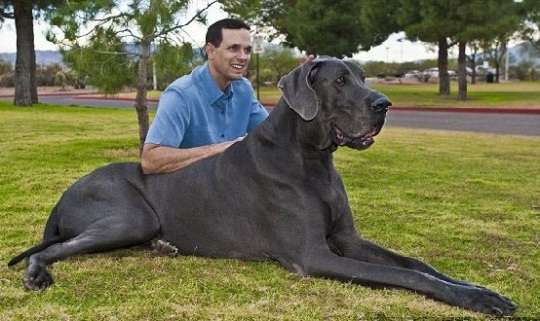
Diet and Nutrition for Blue Great Danes
Proper diet and nutrition are paramount for the health and well-being of your Blue Great Dane. These giants have specific dietary needs, and it’s essential to provide them with the right balance of nutrients. Here’s a handy table to help you understand their dietary requirements:
| Age | Food Type | Portion Size |
|---|---|---|
| Puppy (2-6 months) | High-quality puppy food | 3-6 cups per day, divided |
| Adult (6+ months) | Premium adult dog food | 4-8 cups per day, divided |
Dietary Considerations for Growth and Development
- For optimal growth and development in Blue Great Danes, it’s crucial to feed them high-quality puppy food during their early months, rich in protein and calcium.
- As they transition into adulthood, a premium adult dog food with controlled fat content should be introduced to maintain their ideal body condition and avoid excessive weight gain.
Exercise Needs
- Blue Great Danes require regular exercise to stay healthy and happy, but it’s important not to overexert them, especially during their puppy years, to protect their developing joints.
Appropriate Exercise Routines:
- Daily Walks: Take them for daily walks to help them burn off energy and maintain their muscle tone.
- Moderate Playtime: Engage in moderate playtime in a secure, spacious area to encourage movement and socialization.
- Swimming: Gentle swimming sessions can be excellent low-impact exercise for these large dogs.
- Mental Games: Incorporate mentally stimulating games like hide-and-seek or puzzle toys to exercise their minds as well.
Mental Stimulation
Mental stimulation is vital for Blue Great Danes to prevent boredom and maintain their cognitive health. It’s achieved through:
- Interactive Toys: Provide toys that dispense treats or require problem-solving.
- Training Sessions: Regular training sessions keep their minds engaged and strengthen the bond between you and your dog.
- Variety in Activities: Change up routines and activities to keep them mentally alert and curious.
- Socialization: Regularly expose them to new people, animals, and environments to stimulate their senses.
Grooming Requirements
- Regular Brushing: Brush their short coat weekly with a soft-bristle brush to remove loose hair and maintain skin health.
- Bathing: Bathe them every 2-3 months or as needed, using a gentle dog shampoo to avoid skin irritation.
- Nail Trimming: Trim their nails regularly to prevent discomfort and potential issues with mobility.
- Ear Cleaning: Clean their ears periodically to prevent infections.
- Dental Care: Provide dental care through brushing or dental chews to maintain oral health and fresh breath.
Common Health Issues and Prevention
Here’s a table outlining common health issues in Blue Great Danes, their symptoms, and preventive measures:
| Health Issue | Symptoms | Prevention |
|---|---|---|
| Hip Dysplasia | – Difficulty rising or walking | – Maintain a healthy weight – Provide joint supplements if recommended |
| Bloat (Gastric Torsion) | – Swollen abdomen – Restlessness and discomfort – Unproductive retching | – Feed smaller, more frequent meals – Avoid strenuous exercise after eating |
| Dilated Cardiomyopathy (DCM) | – Coughing – Shortness of breath – Weakness | – Regular heart check-ups – Balanced diet with appropriate nutrients |
| Osteosarcoma (Bone Cancer) | – Lameness or limping – Swelling or pain in bones | – Avoid excessive trauma to the bones – Provide a well-balanced diet |
| Hypothyroidism | – Weight gain – Lethargy – Hair loss | – Regular vet check-ups – Monitoring of thyroid function |
| Wobbler Syndrome | – Unsteady gait – Weakness – Neck pain | – Avoid rapid growth – Maintain a healthy weight |
| Canine Cancer | – Lump or mass – Changes in appetite – Lethargy | – Early detection through regular vet check-ups – Promote a healthy lifestyle |
By being vigilant for these symptoms and taking preventive measures, you can help ensure the well-being of your beloved Blue Great Dane. Regular veterinary check-ups are also essential for early detection and effective management of these health issues.
Training Your Blue Great Dane
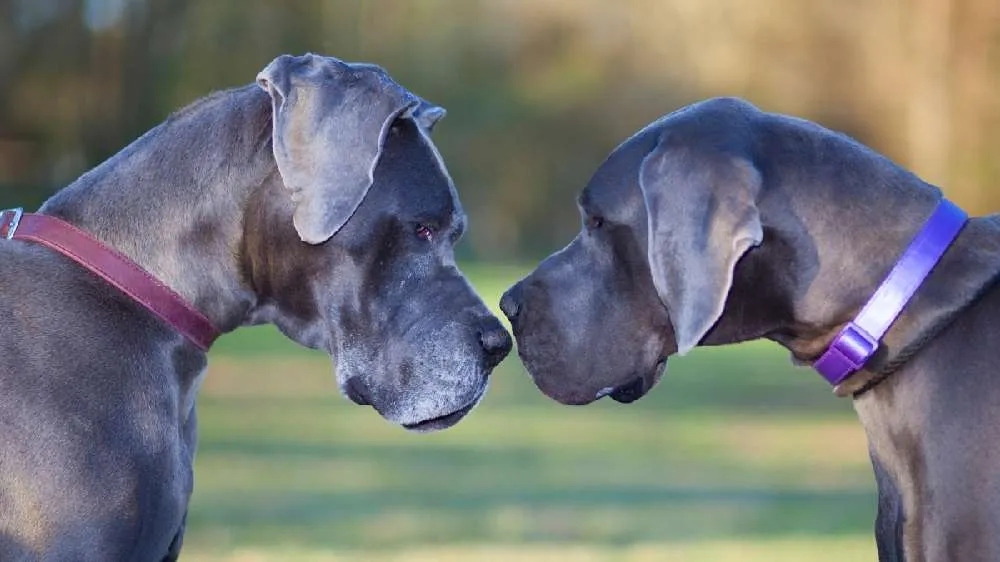
Basic Obedience Training: Building a Foundation
Training your Blue Great Dane in basic obedience is essential for a well-behaved and happy dog. Here’s a list of steps and tips to achieve success:
- Start Early: Begin training as early as possible to establish good habits and a strong bond.
- Use Clear Commands: Use simple, consistent commands like “sit,” “stay,” and “come.” Be clear and firm in your voice.
- Positive Reinforcement: Reward good behavior with treats, praise, or affection. This encourages your dog to repeat the desired actions.
- Consistency: Be consistent with your training schedule and commands, so your dog knows what’s expected.
- Patience: Understand that training takes time and patience. Don’t get frustrated if progress is slow.
Socialization with Other Dogs and People:
Socialization is crucial to ensure your Blue Great Dane is comfortable around other dogs and people. It involves:
- Exposure: Introduce your dog to various people, animals, and environments from a young age.
- Positive Experiences: Make sure these encounters are positive and not overwhelming.
- Training Classes: Consider enrolling in obedience classes or socialization groups to expose your dog to controlled interactions.
Housebreaking Tips and Tricks:
Housebreaking can be challenging, but with these tips and tricks, you can make it easier:
- Consistent Schedule: Establish a regular feeding and bathroom schedule to predict when your dog needs to go out.
- Supervision: Keep a close eye on your puppy and take them outside immediately after eating, drinking, or waking up.
- Use Positive Reinforcement: Praise and reward your dog when they do their business outside.
- Patience: Be patient and avoid scolding for accidents indoors; it’s part of the learning process.
- Clean Accidents Thoroughly: Use an enzymatic cleaner to remove any lingering odors that might attract your dog back to the same spot.
Positive Reinforcement Techniques:
Positive reinforcement is a powerful tool in training your Blue Great Dane. Here are five techniques:
- Treats: Reward good behavior with small, tasty treats.
- Verbal Praise: Use a cheerful and encouraging tone to let your dog know they’re doing well.
- Affection: Petting and cuddling can be a strong motivator for many dogs.
- Toys: Offer a favorite toy as a reward for completing a command correctly.
- Clicker Training: Use a clicker to signal to your dog when they’ve performed the desired behavior, followed by a treat.
The Importance of Consistency in Training:
Consistency is the cornerstone of effective training. It ensures that your Blue Great Dane understands what’s expected of them and helps reinforce good behavior. When you’re consistent in your commands, rewards, and reactions, your dog learns faster and becomes a well-adjusted and obedient companion. Remember, patience, persistence, and positivity go a long way in training your Blue Great Dane to be the best furry friend they can be.
Living with a Blue Great Dane
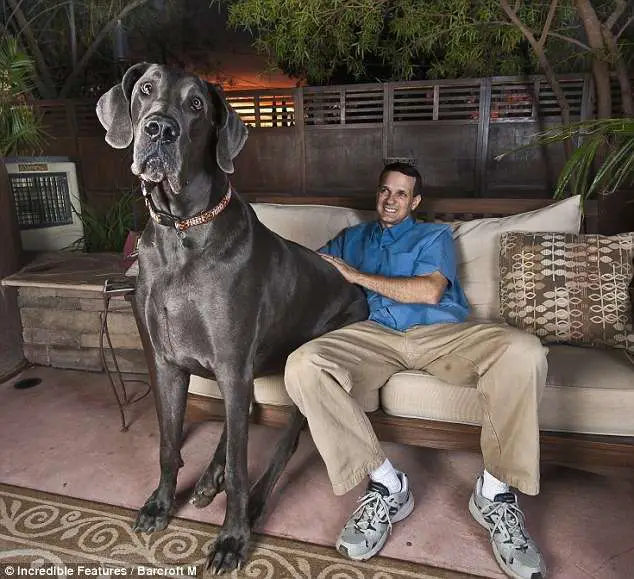
Suitable Living Arrangements:
Choosing the right living arrangements for your Blue Great Dane is crucial to their well-being and happiness.
Apartment vs. House:
- Apartment Living: Blue Great Danes can adapt to apartment living if you provide them with sufficient exercise. However, it’s essential to ensure they have enough space to move comfortably.
- House with Yard: A house with a yard is an ideal setting for Blue Great Danes, as they have room to roam and play. A secure fence is essential to keep them safe.
Yard Size and Fencing:
If you opt for a house with a yard, consider the following:
- Yard Size: A larger yard is preferable to accommodate their size and energy levels. Aim for a yard where they can run and play freely.
- Fencing: Install a secure, tall fence to prevent your Blue Great Dane from wandering. These dogs can be curious, so a well-fenced yard is essential for their safety.
Interaction with Family Members:
Blue Great Danes are known for their affectionate and loyal nature, making them wonderful family pets.
Blue Great Danes as Family Pets:
- They are gentle giants who form strong bonds with their families and often get along well with children and other pets.
- They thrive on human interaction and will want to be a part of your daily activities.
Children and Other Pets:
- Blue Great Danes are typically patient and gentle with children, but their size means supervision is necessary to prevent accidental bumps or falls.
- They can coexist with other pets, but early socialization is essential. They tend to be friendly with other dogs when properly introduced.
Challenges and Rewards of Owning a Blue Great Dane:
Owning a Blue Great Dane comes with both challenges and rewards.
Challenges:
- Size: Their size can be intimidating, and they may accidentally knock over small children or objects.
- Health Considerations: Blue Great Danes are susceptible to certain health issues due to their size, requiring regular vet visits and preventive care.
- Space Needs: Their large size necessitates ample living space and a secure yard.
Rewards:
- Loyalty: They are incredibly loyal and devoted to their families.
- Gentle Nature: Blue Great Danes are known for their gentle and affectionate disposition.
- Magnificent Presence: They make for an impressive and majestic addition to your household.
In summary, living with a Blue Great Dane can be a rewarding experience, provided you have the space and commitment to meet their needs. Their gentle nature and loyalty make them excellent family pets, but it’s essential to be mindful of their size and potential challenges associated with it.
Blue Great Dane as Therapy and Service Dogs
Their Natural Affinity for Helping Humans:
Blue Great Danes possess a remarkable natural affinity for assisting humans in various roles, particularly as therapy and service dogs. Here’s why they excel in these roles:
- Gentle Temperament: Their gentle and compassionate nature makes them highly suitable for providing emotional support and comfort to those in need.
- Empathy: Blue Great Danes often exhibit a deep sense of empathy, allowing them to connect with individuals experiencing physical or emotional challenges.
- Steadiness: Their calm and steady demeanor can have a soothing effect on people dealing with stress, anxiety, or trauma.
Training and Certification Requirements:
To harness their potential as therapy and service dogs, Blue Great Danes need proper training and certification. Key requirements include:
- Basic Obedience: A strong foundation in basic obedience commands, such as sit, stay, and come, is essential.
- Specialized Training: Depending on the specific role (therapy or service), they may require specialized training to perform tasks such as providing physical assistance or emotional support.
- Certification: Certification from reputable therapy or service dog organizations is crucial to ensure they meet the standards and ethics of their respective roles.
Success Stories of Blue Great Danes in Therapy and Service Roles:
Blue Great Danes have demonstrated their remarkable abilities in therapy and service roles, leaving a positive impact on countless lives. Here are some inspiring success stories:
Therapy Dog Comforts Hospital Patients: A Blue Great Dane named Max became a beloved therapy dog at a local hospital. He visited patients, offering companionship and solace to those recovering from surgery and illness. His gentle presence lifted spirits and hastened recovery.
Service Dog Enhances Independence: Luna, a Blue Great Dane, was trained as a service dog for a young girl with mobility challenges. Luna assisted her in daily tasks like opening doors and picking up dropped items. With Luna’s help, the girl gained increased independence and confidence.
School Therapy Dog Supports Children: In an elementary school, a Blue Great Dane named Bella served as a therapy dog. She listened to children read and provided a non-judgmental and comforting presence. Bella’s presence helped improve reading skills and reduced anxiety among students.
These success stories highlight the incredible impact Blue Great Danes can have as therapy and service dogs. Their innate qualities of empathy and gentleness, combined with proper training, make them invaluable assets in improving the lives of those in need.
Finding a Blue Great Dane Puppy
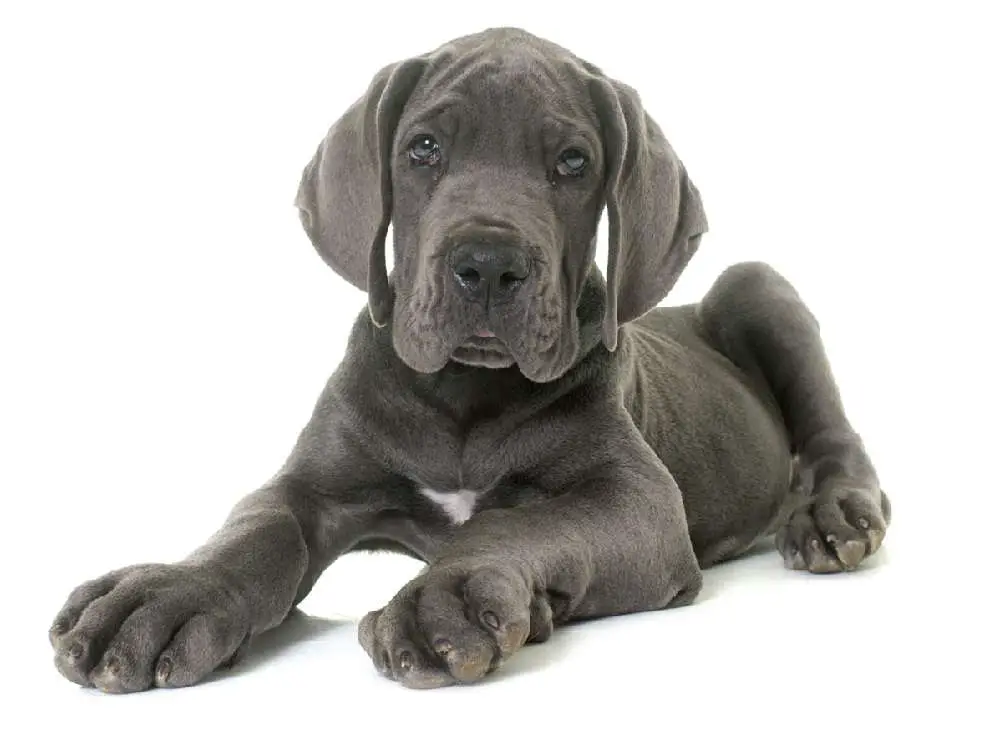
Reputable Breeders vs. Adoption:
When it comes to bringing a Blue Great Dane into your life, you have two primary options: working with reputable breeders or adopting from rescue organizations. Here’s a comparison:
| Aspect | Reputable Breeders | Adoption from Rescue Organizations |
|---|---|---|
| Source of Puppies | Puppies come from carefully selected breeding pairs with known lineage. | Puppies and adult dogs are often rescued from shelters or dire situations. |
| Health and History | Breeders provide detailed health records and information about the puppy’s lineage. | Health records may vary, but rescue organizations often provide medical histories. |
| Ethical Considerations | Responsible breeders follow ethical breeding practices, prioritizing the health and well-being of the dogs. | Adoption supports the rescue and rehabilitation of dogs in need. |
| Puppy Availability | Generally more predictable in terms of available puppies. | Availability may vary depending on the rescue’s current intake. |
| Cost | Usually more expensive due to the investment in breeding and care. | Adoption fees are generally lower and cover vaccinations and spaying/neutering. |
5 Questions to Ask Breeders or Rescue Organizations:
When searching for a Blue Great Dane puppy, it’s crucial to ask the right questions to ensure a responsible and ethical choice. Here are five questions to consider:
- Health History: Can you provide detailed health records for the puppy or dog, including vaccinations, deworming, and any known health issues?
- Parent Information: What can you tell me about the puppy’s parents? Are they screened for breed-specific health concerns?
- Socialization: Has the puppy been properly socialized with people and other animals? Can you describe their temperament?
- Spaying/Neutering: Are there any spaying or neutering requirements or restrictions for the puppy?
- Return Policy: What is your policy if the puppy develops health issues or doesn’t fit into our family as expected?
Red Flags to Watch Out For:
Be vigilant for potential red flags when dealing with breeders or rescue organizations:
- Lack of Health Records: If they cannot provide comprehensive health records or seem hesitant to share them, it may be a sign of transparency issues.
- Overbreeding: Reputable breeders prioritize the health of their dogs and do not engage in excessive breeding. Be cautious if they constantly have litters available.
- Unethical Practices: If the breeder or organization does not prioritize the welfare of the dogs, such as early weaning or inadequate living conditions, it’s a serious concern.
- Avoidance of Questions: If they evade or become defensive when you ask questions about the puppy’s health, lineage, or living conditions, it’s a warning sign.
The Importance of Responsible Breeding Practices:
Responsible breeding practices are essential for maintaining the health and well-being of Blue Great Danes and all dog breeds. Ethical breeders prioritize the following:
- Health Screening: They conduct health tests on breeding dogs to minimize the risk of genetic diseases.
- Proper Socialization: Puppies are raised in a nurturing environment with exposure to various stimuli.
- Selective Pairing: Breeders select mating pairs carefully, considering lineage and genetic diversity.
- Transparency: They are transparent about the puppy’s health history and willingly answer questions.
- Lifetime Care: Responsible breeders commit to providing support and guidance throughout the dog’s life.
Whether you choose to work with a reputable breeder or adopt from a rescue organization, responsible and ethical practices should be at the forefront of your decision. The well-being of the Blue Great Dane and the ethical treatment of all dogs should be a priority in your search for the perfect companion.
You may also read:
Conclusion
In conclusion, the Blue Great Dane is not just a breed; it’s a lifestyle. With their stunning looks, loving personalities, and potential to be true heroes, these dogs have a lot to offer. But remember, with great size comes great responsibility, so be prepared to give them the love and care they deserve. If you’re looking for a four-legged friend who will stand by your side and steal your heart, the Blue Great Dane might just be the perfect fit for you.
So, are you ready to embark on this journey with a Blue Great Dane by your side? Get ready for a life filled with joy, slobbery kisses, and unforgettable moments!
Additional Resources
Links to Breed Clubs, Forums, and Organizations:
- Great Dane Club of America: The official club dedicated to Great Danes, which often includes resources specific to Blue Great Danes.
- Blue Great Dane Club: A club and community specifically focused on Blue Great Danes, offering information, events, and networking.
Recommended Books and Articles:
- Book: “The Great Dane: Gentle Giant” by Randall Lockwood and Katya Harrell. This comprehensive book explores the breed’s history, care, and training.
- Article: Blue Great Dane Information: The American Kennel Club provides valuable information about the breed, including Blue Great Danes.
Videos and Documentaries:
- Great Dane – The Gentle Giant: A documentary that explores the history and characteristics of the Great Dane breed.
- Blue Great Dane Puppy Compilation: A cute and informative video showcasing adorable Blue Great Dane puppies.
FAQs About Blue Great Danes
1. Are Blue Great Danes hypoallergenic?
- No, Blue Great Danes are not hypoallergenic. They shed dander and hair, which can trigger allergies in sensitive individuals.
2. Do Blue Great Danes need special grooming due to their color?
- Their coat care is similar to that of other Great Danes. Regular brushing to control shedding and occasional baths are essential.
3. Can Blue Great Danes swim despite their size?
- Yes, Blue Great Danes can swim. However, they are not natural swimmers, so early and gentle introductions to water are recommended.
4. How do Blue Great Danes handle cold weather?
- Blue Great Danes have a short coat and are sensitive to cold. They should have access to shelter and warm bedding in chilly conditions.
5. Are Blue Great Danes more prone to certain health issues due to their color?
- There is no direct link between coat color and specific health issues. However, all Great Danes, regardless of color, should be monitored for breed-specific concerns like bloat and hip dysplasia.

